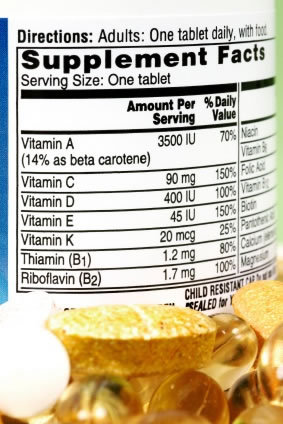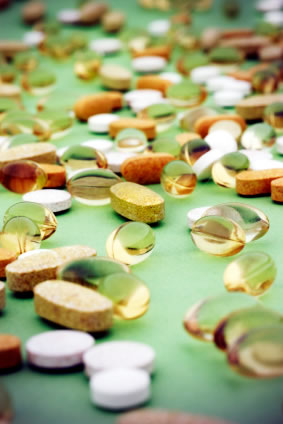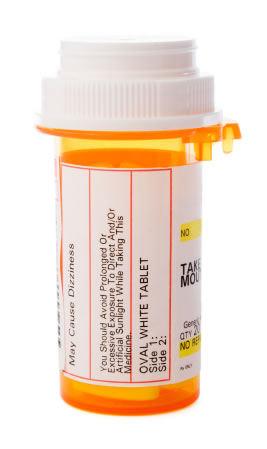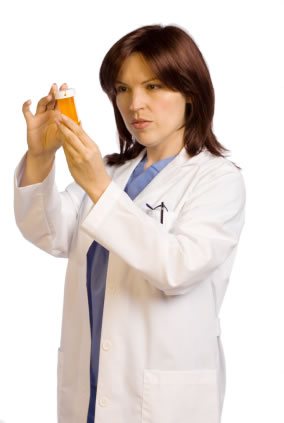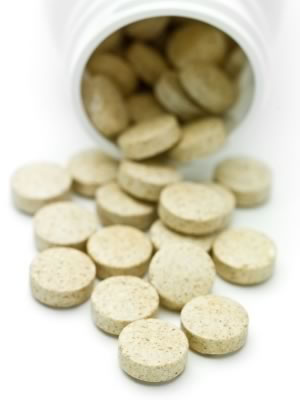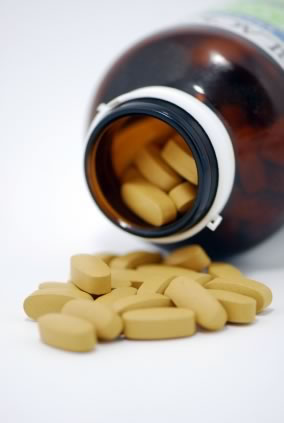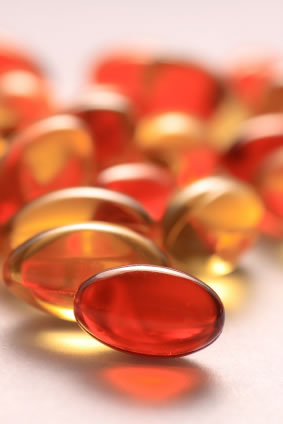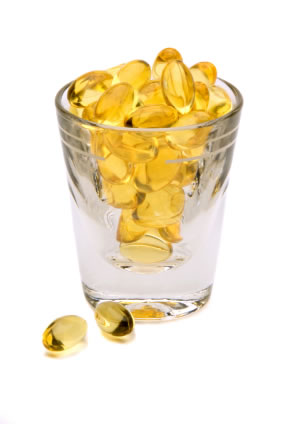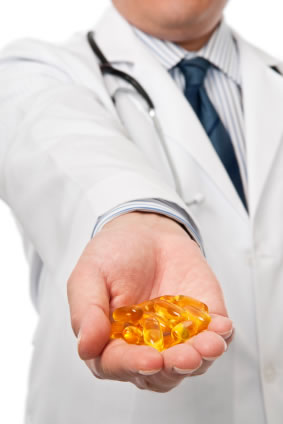A vitamin is a natural substance that is required by the human body in order for it to grow and develop. Vitamins provide a source of energy that is used for metabolism in the body as well as promote health by the prevention of certain illnesses. Vitamins are made up of chemical elements that must be obtained from food. It is essential, therefore, that the human diet contains a blend of foods that will provide vitamins in order to maintain a healthy status.
Vitamins are categorized as two different kinds: fat soluble, which are stored in body tissues, and water soluble. The water soluble vitamins are also known as the B-complex vitamins as well as vitamin C. These water soluble vitamins are not able to be stored within the body and are excreted after a short period of time. Therefore, in order to maintain adequate levels of water soluble vitamins, they must be replenished daily in the diet. Eating a diet of certain foods that contain B-complex vitamins as well as vitamin C will promote adequate nutrition and will provide the benefits of health and protection against many diseases.
Use in Nutrition
When a person eats food that contains water soluble vitamins, it passes through the stomach and into the small intestine where the vitamins are absorbed and distributed throughout the body through the blood stream. The exception to this is vitamin B12, which requires the presence of intrinsic factor, a substance produced in the stomach that allows for absorption in the small intestine.

Without intrinsic factor, the body cannot absorb vitamin B12. After absorption, water soluble vitamins are only of use in the body for their necessary tissues and, if too much is available, the body will excrete the excess. Water soluble vitamins eventually are excreted either through the urine or feces, requiring replacement vitamins daily.
Types of Water Soluble Vitamins
Vitamin B1 (thiamine)
Vitamin B1 is also referred to as thiamine and was one of the first B-complex vitamins discovered for its nutritional properties. Thiamine is found in many foods, particularly in grains such as whole wheat and oatmeal; fruits and vegetables, such as asparagus and oranges; and seeds, such as flaxseed and sunflower seeds.
Many grains, in particular those found in white bread, are required to have thiamine added as part of an enrichment process in order to replace any that may have been lost. The recommended daily allowance of thiamine is 1.4 milligrams, although taking in more than this amount has not been shown to have adverse effects.
Thiamine Deficiency
Because thiamine is frequently found in many foods, a deficiency of this type of vitamin is typically associated with other illness that results in a person being unable to acquire the needed amounts of the vitamin. Situations such as gastrointestinal illnesses that may inhibit the absorption of thiamine may lead to a deficient state.
Alcoholism can also result in a thiamine deficiency, as the affected person may have insufficient nutrition and vitamin intake. Alcoholism, when severe, can impair the body’s ability to absorb thiamine from the gastrointestinal tract as well as impairing liver function.
There are two main diseases associated with a deficiency of Vitamin B1. The first is beriberi, which is classified as being either wet or dry. Wet beriberi may affect the cardiovascular system by causing symptoms of rapid heart rate, swelling in the extremities, and shortness of breath. The symptoms of wet beriberi can be similar to those of congestive heart failure.
Dry beriberi affects the neurological system and symptoms include confusion, numbness and tingling of extremities, paralysis, difficulty with motor coordination and walking, pain, and involuntary eye movements. Treatment is aimed at replacing the thiamine deficiency, which provides rapid relief of symptoms. Severe damage may be irreversible, even with proper vitamin supplementation.
Wernicke’s encephalopathy (also referred to as Wernicke-Korsakoff syndrome or alcoholic encephalopathy) is a condition of thiamine deficiency that eventually causes damage to the brain, resulting in neurological symptoms. It is associated with alcoholism due to the number of patients seen with the illness as a result of heavy drinking.
Symptoms include difficulty with walking and motor coordination, memory loss, hallucinations, and involuntary eye movements. The condition is treated by giving thiamine, which will reduce symptoms but may not reverse neurological damage, such as memory loss.
Vitamin B2 (riboflavin)
Vitamin B2 is also called riboflavin and is available in many foods. Many people choose to take a vitamin supplement to increase the amount of B-complex vitamins they are receiving daily in order to promote health. The recommended daily allowance of Vitamin B2 is 1.1 to 1.3 milligrams.
Riboflavin has been shown to reduce cataracts and migraine headaches in some patients, as well as help with symptoms of anemia. Riboflavin is an antioxidant and works as a protector within the body, destroying free radicals that work to slow growth and development or that may cause cancer. Riboflavin is found in whole grains and yeast; vegetables, such as broccoli and spinach; and dairy products, such as milk, yogurt, and eggs.
Riboflavin Deficiency
Riboflavin deficiency results in a condition called ariboflavinosis, which most commonly occurs with those that have a diet lacking in sufficient nutrients. Ariboflavinosis typically occurs in conjunction with other vitamin deficiencies, so for the person lacking riboflavin, there may be other vitamin insufficiencies as well. Ariboflavinosis can also occur in persons suffering from alcoholism, as alcohol can be destructive to the gastrointestinal tract, preventing its ability to absorb the vitamin.
Symptoms of ariboflavinosis are red and cracked lips; cracking at the corners of the mouth; sensitivity to light; itchy, watery eyes; ulcers in the mouth; and dermatitis. Treatment of the condition includes increasing the amount of Vitamin B2 in the diet, or in severe cases, riboflavin supplements in vitamin form.
Niacin (Vitamin B3)
Vitamin B3 is typically called by the name niacin. Niacin is found in many foods and a deficiency is uncommon, except in extreme cases of malnutrition or alcoholism. Niacin is added to many cereals and breads as a fortifier to add amounts to the diet. The recommended daily allowance of niacin is 14 to 16 milligrams daily. Niacin works to help the body’s circulatory system and can improve cholesterol levels. It has been used to treat high levels of triglycerides and LDL cholesterol.
It is also beneficial in reducing atherosclerosis, which is the buildup of fatty tissue within the blood vessels. Niacin is found in meats such as chicken, beef, or fish; dairy products, such as milk and eggs; vegetables, such as broccoli, carrots, and asparagus; as well as mushrooms and yeast.
Niacin Deficiency
Lack of niacin in the diet is unusual in developed countries where diets are fortified and complete. A niacin deficiency causes a condition called pellagra, a disease that if left untreated, will result in death. Symptoms of pellagra include difficulty walking and problems with motor coordination; diarrhea; inflammation of the skin; hair loss; a red, swollen tongue; skin lesions; weakness; and cognitive changes. Treatment is available through measured doses of niacin to control toxicity.
Vitamin B6 (Pyridoxine)
Vitamin B6 is one of the B-complex vitamins that is frequently found in foods, although deficiencies in this vitamin have been seen in the elderly or in children with unbalanced diets. Vitamin B6 is also called by its lesser known name, pyridoxine. The recommended daily allowance of vitamin B6 is 1.3 to 1.7 milligrams, depending on age.
Vitamin B6 is responsible for building up some of the neurotransmitters in the brain that contribute to elevated mood and decreased depression. For this reason, it has been used in the treatment of some mood disorders as a supplement. Vitamin B6 also is helpful in reducing cardiovascular disease in the body and maintaining good heart health.
Finally, it is an essential component of the absorption of Vitamin B12 by the body and the two vitamins work closely together for health maintenance. Vitamin B6 is found in many foods, including poultry and fish, such as chicken, turkey, and shrimp; grains, such as whole wheat and wheat germ; vegetables, such as carrots and spinach; and dairy, such as milk and eggs.
Vitamin B6 Deficiency
A deficiency of vitamin B6 is rare, but can be seen in patients with medical conditions, such as those undergoing dialysis. Vitamin B6 deficiency used to be seen more commonly as a pediatric illness, referring to the lack of the vitamin received by infants eating certain types of formula. The condition is rare today with the fortification of most infant formulas in the United States.

Symptoms of vitamin B6 deficiency include red, chapped lips; skin rash; inflammation of the tongue, with mouth ulceration; and conjunctivitis. A mild form of the illness may result in symptoms of depression, related to the vitamin’s effect on serotonin in the body, a neurotransmitter that stabilizes the mood.
Folic Acid (Vitamin B9)
Folic acid is probably best known for its essential supplementation needed for women that are pregnant. Folic acid assists the body in the development and growth of tissues and body systems, particularly during infancy and childhood. It also facilitates the growth of a fetus during pregnancy and can lessen the risk of certain birth defects that may form during gestation. Folic acid provides stability for mood function and cognitive abilities and contributes to overall mental health.
The recommended daily allowance of folic acid is 400 micrograms per day, with an increase to 600 micrograms per day recommended for women that are pregnant or that are planning to become pregnant.
Folic acid is found in a variety of foods, particularly in vegetables, such as spinach, asparagus, Brussels sprouts, and beans; orange juice; milk; and whole grains. Most breads and cereals are fortified with this vitamin to provide added supplementation for the diet.
Folic Acid Deficiency
A deficiency in folic acid can occur in those with an unbalanced diet, or persons suffering from a medical disorder that disrupts absorption of vitamins within the gastrointestinal system. Folic acid deficiency is characterized by a sore tongue and inflammation of the gums; diarrhea; loss of appetite; and depression.
Women that are deficient in folic acid during pregnancy have a greater risk of having a baby with a neural tube defect, which includes the areas of the brain and spinal cord. Types of neural tube defects include spina bifida, meningocele, and cleft lip and palate. Supplementation of folic acid is particularly important for the woman considering pregnancy, as the structures of the brain and spinal cord develop in the early weeks of gestation, possibly before a woman may know she is pregnant.
Vitamin B12 (Cobalamin)
Vitamin B12 is important in the regulation of nerve centers within the body: those that are responsible for connection between the brain and motor coordination, as well as stabilization of mood. Vitamin B12 is also responsible for adjusting the body’s immune cells, which can keep a person healthy.
It works alongside folic acid to control the creation of red blood cells, providing needed oxygen to all parts of the body. Vitamin B12 is absorbed in the stomach by stomach acid, and it is found in foods that come from animals, namely beef; poultry; fish; eggs; and milk. Its recommended daily allowance is 2.4 micrograms.
Vitamin B12 Deficiency
A deficiency in vitamin B12 can occur with those that eat unbalanced diets, people with a medical illness that causes malabsorption of vitamins, and those that do not eat meat or dairy products. Since stomach acid is needed for the absorption of vitamin B12, the elderly are also at increased risk of deficiency, as stomach acid reduces in amounts as the body ages.
Symptoms of vitamin B12 deficiency include shortness of breath; numbness and tingling of the extremities; fatigue; and diarrhea. Symptoms of mild vitamin B12 deficiency may go unnoticed for a period of time until severe. Untreated, severe vitamin B12 deficiency can cause cognitive changes and damage to the neurological system.
Pernicious anemia is a condition characterized by the body’s inability to absorb vitamin B12. Persons with this illness must take regular supplements of the vitamin, usually in the form of injection daily, in order to retain an adequate amount in the body for proper functioning and to avoid permanent damage.
Biotin (Vitamin B7)
Biotin has also been referred to as Vitamin H, and is a necessary component for strength in finger and toenails, skin, and hair. This vitamin is also needed for development during pregnancy, making it an essential vitamin required for proper growth of a fetus. Biotin can be found in several foods in small concentrations.
It is commonly found in eggs (cooked); nuts, such as walnuts, peanuts, and almonds; legumes and beans; mushrooms; and bananas. The recommended daily allowance of biotin is 30 micrograms daily for adults.
Biotin Deficiency
A deficiency in biotin is uncommon, as the necessary amounts needed for health are considered low in comparison with many of the other water soluble vitamins. Biotin may be produced by some intestinal flora found in the body in situations where a deficiency may occur.
Nevertheless, there are some circumstances that cause biotin deficiency in certain populations. Persons that eat egg whites over a long period of time can develop a deficiency in the vitamin.
Biotin is available in cooked eggs as part of the yolk, but when raw, egg whites have a substance called avidin that does not allow the body to absorb biotin. People that take certain antibiotics or anticonvulsants may be at risk for developing biotin deficiency, as these medications may inhibit the body from absorbing the vitamin.
Symptoms of biotin deficiency include changes in the texture of hair and hair loss; dry, rashy skin; fungal infections; depression; numbness and tingling of the extremities; and cognitive changes. The condition is treated with biotin supplementation.
Pantothenic Acid (Vitamin B5)
Vitamin B5, also called pantothenic acid is extremely common as a vitamin in many sources of food. It is needed for control of cholesterol and triglycerides in the body, to reduce the occurrence of atherosclerosis in the blood vessels. Pantothenic acid has also been known to help the body manage stress and it has been shown to be of some benefit for those suffering from the effects of rheumatoid arthritis.
It is found in a large number of foods, although some processing methods may reduce the amount of the vitamin. Vitamin B5 is found in meats, such as chicken, beef, and duck; beans and legumes; vegetables, such as corn, broccoli, avocado, and sweet potatoes; nuts and seeds, such as peanuts and sunflower seeds; whole grains; yeast; and milk. The recommended daily allowance for pantothenic acid is five milligrams.
Pantothenic Acid Deficiency
Symptoms of pantothenic acid deficiency are very rare and usually occur within populations that are extremely malnourished. Symptoms include depression and fatigue; abdominal pain; vomiting; and irritability. The condition is treated with an adequate diet or supplementation when necessary.
Vitamin C (Ascorbic Acid)
Also known as ascorbic acid, vitamin C is a necessary element in many functions of the body. Vitamin C is responsible for the production of collagen in the body, a substance that is the foundation of ligaments and tendons; skin; and blood vessels. It also helps the body during the healing process, so that wounds and injuries heal more quickly.
Vitamin C is found in many foods, and is well-known as a substance in a variety of citrus fruits. Lemons, limes, grapefruit, and oranges are all sources of the vitamin. It is also found in vegetables, such as peppers, tomatoes, squash, cabbage, broccoli, and spinach; and other fruits, such as pineapple, blueberries, cranberries, strawberries, raspberries, and kiwi. The recommended daily allowance of vitamin C is 75 to 90 milligrams.
Vitamin C Deficiency
Mild vitamin C deficiency can be common among children, the elderly, and those that do not consume adequate amounts of fruits and vegetables. Cigarette smokers are also at increased risk of vitamin C deficiency as the ingredients of cigarette smoke reduce the amount of the vitamin within the body. Symptoms of mild vitamin C deficiency include dry skin, nosebleeds, bruising easily, and brittle hair.
Severe deficiency of vitamin C causes a condition known as scurvy, which is rarely seen in developed countries today. Historically, scurvy was often seen in sailors that travelled for weeks by boat without fresh fruits and vegetables in their diets.
The disease was eventually treated by stocking limes as a part of the food sources on each voyage, thereby reducing the amounts of the illness among that population. The disease can be very severe and will lead to death if left untreated. Symptoms of scurvy include all of the listed signs of mild vitamin C deficiency. In addition, bleeding and soft gums; loss of teeth; pallor; bleeding; slow wound healing; depression; and paralysis are all associated with the disease.
Sources:
1. University of Maryland Medical Center: Vitamin B1 (thiamine)
2. Colorado State University: Water Soluble Vitamins
3. Healthwise: Vitamin B3
4. Linus Pauling Institute: Vitamin B6
5. University of Maryland Medical Center: Vitamin H (biotin)
6.Ohio State University: Folate
7. University of Michigan Health System: Vitamin B12
8. Linus Pauling Institute: Pantothenic Acid
9. Ohio State University: Vitamin C


